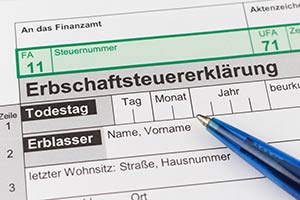Current
informs.
All news at a glance.

We keep you up to date
We bring you the latest developments and news directly to your screen!
Current dates and developments always in view.
Inheritance tax reform for business assets
With a delay of several months, the legislator has now implemented the requirements of the Federal Constitutional Court on inheritance tax on business assets.
For almost two years, the federal and state governments fought over a reform of the inheritance tax until a final agreement was reached. Following the Bundestag, the Bundesrat also approved the reform of the inheritance tax in the form agreed by the Mediation Committee, meaning that the new rules can now enter into force retroactively as of July 1, 2016. Politicians have thus overrun the deadline for reform set by the Federal Constitutional Court by several months, but at least a solution was found before the court itself took action.

The reform retains the previous concept of preferential treatment of business assets, but makes numerous adjustments to comply with the requirements of the Federal Constitutional Court. In addition, there are also some relief measures for heirs, but these are largely tied to certain conditions. We have summarized below the rules that now apply to inheritance tax on business assets.
-
Rule sparing: As under the previous law, the beneficiary assets are exempt from tax at the option of the acquirer at 85 % or 100 % if certain conditions are met. If the acquirer opts for the standard exemption of 85 %, he must continue the business for at least five years and prove that the total payroll does not fall below 400 % of the initial payroll within five years of the acquisition (payroll regulation).
-
Option Verschonung: If the full exemption from inheritance tax is chosen, the acquirer must observe a retention period of seven years and prove that he or she will not fall below the payroll of 700 % during this period.
-
Small businesses: Previously, companies with up to 20 employees were completely exempt from the payroll regulation. This limit was too generous for the Federal Constitutional Court, which is why the requirements are now staggered according to the number of employees. Only companies with up to 5 employees will be completely exempt from the payroll rule. Companies with 6 to 10 employees may not fall below a payroll of 250 % of the initial payroll within the five-year retention period. For the option exemption, the wage total is 500 % within seven years. For companies with 11 to 15 employees, wage totals of 300 % and 565 % apply accordingly. No relief is provided for 16 employees or more. Employees on maternity or parental leave, apprentices, seasonal workers and those on long-term sick leave are not included in either the number of employees or the wage total.
-
Large operating assets: In the case of the acquisition of company assets with a favored asset value of more than EUR 26 million (test threshold), there is now a right to choose between a need for tax relief test or a tax relief discount. For the threshold, all acquisitions from the same person within 10 years are added together, which means that the exemption can also be partially eliminated retroactively.
-
Needs Assessment: In the exemption needs test, the acquirer must disclose his private assets and thus prove that he is not in a position to pay the tax from existing assets or from non-benefited assets received at the same time as the inheritance or gift. If 50 % of such assets are not sufficient to pay the tax, the excess portion of the tax shall be waived on a pro rata basis.
-
Tax Credit: Alternatively, the acquirer can opt for a tax reduction model. Starting from the normal tax relief of 85 % or 100 % for assets below EUR 26 million, the tax relief decreases by 1 % for each additional EUR 750,000 above this threshold up to a beneficiary asset of EUR 90 million.
-
Administrative assets: Under the previous law, a share of administrative assets of up to 50 % is not harmful and is also tax-privileged. In the future, only the favored assets can be spared from tax, but not the administrative assets. The catalog of items that expressly count as administrative assets has also been expanded. These now also include stamp collections, vintage cars, yachts, gliders and other items typically used for private purposes if the production, processing, leasing or trading in these objects is not the main purpose of the business.

-
Exceptions: Administrative assets are treated as tax-privileged assets up to a share of 10 % of the business assets. However, young administrative assets that have been attributable to the business for less than two years are exempt. In order to ensure the liquidity of the business, cash assets, monetary receivables and other financial resources up to a share of 15 % of the business assets are also favored. Administrative assets that serve exclusively and permanently to meet pension obligations are also eligible. However, this is subject to the condition that the corresponding assets are not accessible to all creditors who are not directly entitled under the pension obligations.
-
Limits: In order to claim the option relief of 100 % for the beneficiary assets, the administrative assets may not account for more than 20 % of the enterprise value. Conversely, if the share of administrative assets exceeds 90 %, there is no exemption at all, not even for assets that are actually beneficiaries.
-
Shareholdings and corporate groups: In multi-level corporate structures with associated companies, the beneficiary assets are determined on a consolidated basis. It is no longer possible to utilize the administrative asset share at each investment level, as was permitted under the old law.
-
Investment clause: Assets from the inheritance do not count as administrative assets if they are used within two years of the testator's death for investments in the company that serve an original commercial activity. An investment in another form of administrative assets is therefore not eligible. A further requirement is that the investment is made on the basis of a plan already drawn up by the testator, i.e. is merely implemented by the heir.
-
Family business: If certain restrictions typical of family businesses exist in the articles of association or partnership agreement, there is an advance tax deduction of up to 30 % on the favored portion of the business assets. The amount of the deduction is based on the percentage reduction of the compensation for a departing shareholder compared to the fair market value as stipulated in the partnership agreement. Furthermore, there must be a restriction on profit distributions or withdrawals and a restriction on disposal of the company shares. In addition, the discount requires that the restrictions under company law exist for a period of at least 2 years before and up to 20 years after the transfer of assets.
-
Enterprise value: In the simplified capitalized earnings value method, the calculation of the enterprise value is changed so that the values are again somewhat lower. Under this method, the enterprise value is calculated by multiplying the sustainable annual earnings by a capitalization factor. This factor was previously calculated directly from the respective current base interest rate - the lower the interest rate, the higher the capitalization factor. However, the ongoing low-interest phase has now led to a capitalization factor of 17.86 and thus to unrealistically high company values. Now the factor is fixed at 13.75 for the current year. The Federal Ministry of Finance is then to adjust the factor to interest rate developments as required. This change is the only one to apply retroactively to January 1, 2016 and thus to all business transfers made this year.
-
Tax deferral: In the case of an inheritance - i.e. not a gift - the portion of the inheritance tax attributable to the tax-privileged business assets is deferred for up to seven years on application. In the first year, the deferral is interest-free; thereafter, the general interest rules for deferrals apply. However, the deferral is subject to compliance with the payroll and retention period requirements. In the event of non-compliance, the deferral ends automatically.
The delay in passing the inheritance tax reform came about because the bill on which the Grand Coalition had agreed was referred to the Mediation Committee by the Bundesrat. The result of the mediation process now essentially follows the amendments to the original bill, albeit with some tightening up of details. As befits a good compromise, no one is really happy with the law that has been passed. While this is commonplace for politicians, it is rare to hear clear criticism from experts even after the legislative process has been completed.
Nevertheless, some experts remain convinced that the new inheritance tax law is still unconstitutional. Whether this is actually the case can only be decided by the Federal Constitutional Court in the context of new proceedings. Given the concerns, such proceedings will relatively certainly come sooner or later, but for the foreseeable future, the new law will stand.
The new law is undoubtedly closer to the requirements of the Constitutional Court than the old law, and even the latter was allowed to continue to apply by the court until the new regulation came into force. Any further tightening based on a new procedure will therefore not only take several years, but will certainly not apply retroactively. In other words, for the foreseeable future, there is now planning security again when planning an optimal business and generational succession.